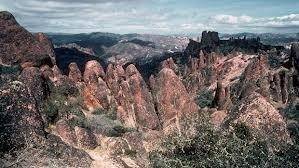В
Secretary of the Interior Ken Salazar and Director of the National Park Service Jonathan B. Jarvis today celebrated the establishment of America’s 59th national park with President Obama’s signature of legislation to elevate Pinnacles National Monument to become Pinnacles National Park.
В
“This ancient and awe-inspiring volcanic field with its massive monoliths, spires, cave passages and canyons is a place that restores our souls and energizes our bodies with its beauty and abundant opportunities for outdoor recreation,” Salazar said. “I commend Rep. Sam Farr and Sen. Barbara Boxer for their vision in sponsoring the legislation to make it a national park.”
“As with our other national parks and lands, Pinnacles also is an economic engine, supporting jobs in local communities,” he said, noting that last year Pinnacles hosted more than 343,000 visitors. Each year, visitors spent about $4.8 million and support 48 jobs in the local economy.
Rising out of the Gabilan Mountains east of central California’s Salinas Valley, Pinnacles is the result of millions of years of erosion, faulting and tectonic plate movement. Within the park’s boundaries lie nearly 27,000 acres of diverse wild lands. Visitors delight in the beauty and variety of its spring wildflowers and more than 400 species of native bees. The Pinnacles rock formations are a popular destination to challenge technical and beginner climbers alike.
Designated as a national monument in 1908 by President Theodore Roosevelt, the park’s management will not change by the legislation. The Pinnacles National Park Act recognizes the broader significance of park resources, specifically the chaparral, grasslands, blue oak woodlands, and majestic valley oak savanna ecosystems of the area, the area’s geomorphology, riparian watersheds, unique flora and fauna, and the ancestral and cultural history of native Americans, settlers and explorers.
“We are proud to add Pinnacles to our family of national parks,” said Jarvis. “The beauty of the land and the diversity of recreational and educational opportunities offer a unique experience to every visitor. Pinnacles is a place worthy to be called part of вЂAmerica’s Best Idea.'”
Pinnacles National Park is also well known as an incubator of America’s fragile population of California Condors. It is one of three condor release sites in the country, and the only release site in a national park. Pinnacles has been a partner of the California Condor Recovery Program since 2003. The park manages 31 free-flying condors. Each bird is monitored after its release to increase its chances of survival. Park biologists and volunteers monitor chicks hatched in the wild. They check blood and feather samples for signs of poisoning from ingestion of lead-contaminated food. They also monitor condors to aid research about their habitat and movement.
In addition to changing the park’s status from national monument to national park, the legislation names the park’s 16,000 acres of wilderness as the Hain Wilderness. The name honors Schuyler Hain who was an 1891 homesteader from Michigan. Within 20 years he became known as the “Father of Pinnacles” leading tours up through Bear Valley and into the caves. Hain spoke to groups and wrote articles urging preservation of the area and acted as unofficial caretaker for many years. His efforts proved fruitful with the establishment of Pinnacles as a 2,500-acre national monument in 1908 by President Theodore Roosevelt.
The rock formations of Pinnacles National Monument and the Gabilan Mountain Range divide the park into East and West Districts which are connected by trails, but not by a vehicle road. More than 30 miles of trails access geological formations, spectacular vistas and wildland communities. Pinnacles National Park is a day-use park, with occasional full moon hikes and dark sky astronomical observations led by ranger-interpreters.
The National Park System is more than 84 million acres in size and contains 398 natural, cultural and historic landscapes. This system includes 59 national parks, 125 national historical parks, national and international historic sites, 75 national monuments, as well as many national memorials, battlefields, parkways, preserves, recreation areas, seashores and lakeshores and trails.
В

